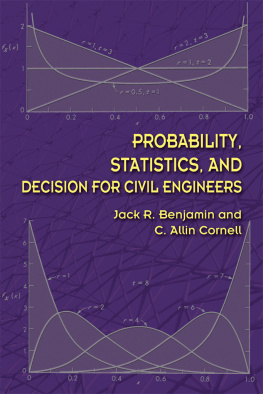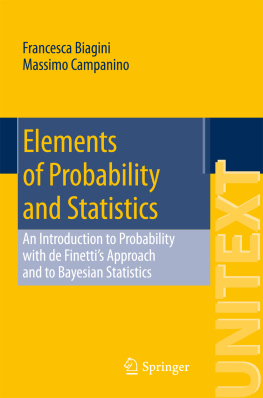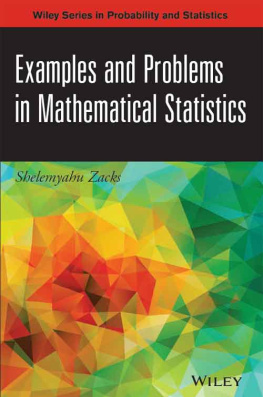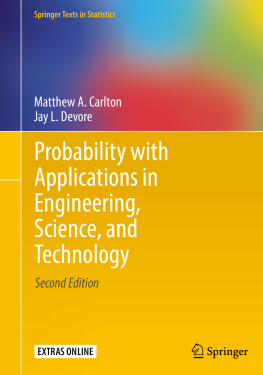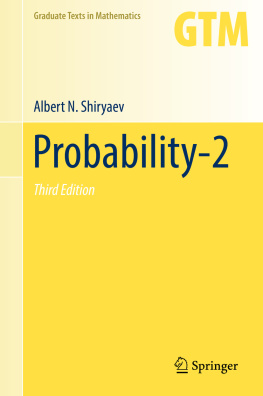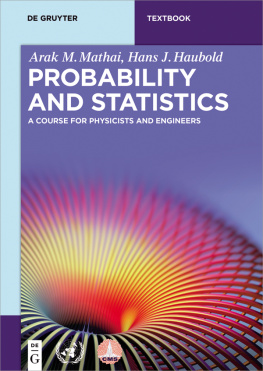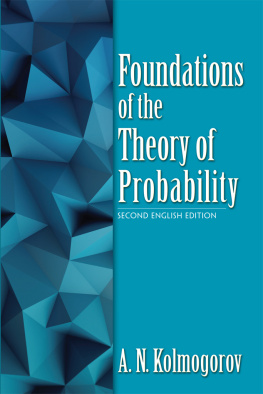PROBABILITY, STATISTICS, AND DECISION FOR CIVIL ENGINEERS
PROBABILITY, STATISTICS, AND DECISION FOR CIVIL ENGINEERS
Jack R. Benjamin
and
C. Allin Cornell
DOVER PUBLICATIONS, INC.
Mineola, New York
Copyright
Copyright 1970 by Jack R. Benjamin and C. Allin Cornell
All rights reserved.
Bibliographical Note
This Dover edition, first published in 2014, is an unabridged republication of the work originally published by McGraw-Hill, Inc., New York, in 1970.
Library of Congress Cataloging-in-Publication Data
Benjamin, Jack R. (Jack Ralph), 19171998, author.
Probability, statistics, and decision for civil engineers / Jack R. Benjamin, C. Allin Cornell. Dover edition.
pages cm
Reprint of: New York : McGraw-Hill, 1970.
Summary: This text covers the development of decision theory and related applications of probability. Extensive examples and illustrations cultivate students appreciation for applications, including strength of materials, soil mechanics, construction planning, and water-resource design. Emphasis on fundamentals makes the material accessible to students trained in classical statistics and provides a brief introduction to probability. 1970 edition Provided by publisher.
eISBN-13: 978-0-486-31570-6
1. Probabilities. 2. Mathematical statistics. 3. Bayesian statistical decision theory. I. Cornell, C. Allin, author. II. Title.
TA340.B45 2014
519.5dc23
2014012854
Manufactured in the United States by Courier Corporation
78072401 2014
www.doverpublications.com
To Sarah and Elizabeth
Preface
This book is designed for use by students, practitioners, teachers, and researchers in civil engineering. Most books on probability and statistics are intended for readers from many fields, and therefore the question might be asked, Why is it necessary to have a book on applied probability and statistics for civil engineers alone? Further, within civil engineering itself, we might ask, Why is it reasonable to attempt to write to an audience with such widely varying needs? The need for writing such a book is a result of the unusual status of probability and statistics in civil engineering.
Although virtually all forward-looking civil engineers see the rationality and utility of probabilistic models of phenomena of interest to the profession, the number of civil engineers trained in probability theory has been limited. As a result there has not yet been widespread adoption of such models in practice or even in university courses below the advanced graduate level. Indeed, there has not yet been sufficient development of such models to permit a unified probabilistic approach to the many aspects of the strength of materials, soil mechanics, construction planning, water-resource design, and many other subjects where the methods could clearly be useful.
Many departments of civil engineering now require that their students study probability or statistics. Subsequent undergraduate technical courses, however, usually lack material that draws upon that study, and this often leaves the student without an appreciation for possible implications of the theory. Through the use of illustrations and problems taken solely from the civil-engineering field this book is designed to develop this appreciation for applications. It can serve as a primary text for a course within a civil-engineering department or as a supplementary text for courses taught in other departments. The major compromise here was the acceptance of the risk of obscuring or confusing the basic theory in describing the illustrative physical problem. We could have avoided this risk by using only examples dealing with coins, dice, red and black balls, etc., but the desire to develop the ability to construct mathematical models of physical phenomena in civil-engineering applications weighed heavily in favor of professional illustrations.
Students finishing such a professionally oriented probability course may or may not go on to advanced courses in the theory. This consideration dictated at least an introductory coverage of a wide variety of material coupled with a thorough treatment of the fundamentals. The kinds of compromises involved in trying to decide between breadth in subject matter and depth in fundamentals are obvious. It is unlikely that our many decisions of this kind will be judged optimal by all, or, indeed, by ourselves in time.
This emphasis on a thorough understanding of fundamentals, on a broad coverage of subject matter, and on illustrations drawn from familiar practice are appropriate for a book aimed at a growing number of practicing civil engineers, researchers, and students who have an interest in teaching themselves the elements of applied probability and statistics. Here the continued exposure to professionally based illustrations, as simplified as they may be, can help to sustain that interest and stimulate ideas for developments of direct personal concern. (Although it is not a basic aim, the usefulness of the text as a reference book is enhanced by a number of convenient tables.)
A book designed for a broad audience of civil engineers is also important because the training of civil engineers familiar with probability and statistics is presently widely varied in depth, breadth, and source. Many misuses and misinterpretations of probability and statistics exist in practice and in the professions literature. The emphasis in this book on depth in fundamentals is again critical. In a number of places in the book a significant effort has been made to place additional emphasis on commonly misunderstood points. To the beginning reader the effort and words may seem excessive, but it is hoped that these discourses will serve as warnings to the reader to be particularly alert when similar situations are encountered. Readers with some experience in applications of probability and statistics will recognize these subjects and perhaps benefit by the additional discussion. It is hoped in particular that readers who have studied only statistics in the past will appreciate the opportunity to study the probability theory upon which statistics is based. A common reaction to such a study is, on one hand, surprise at the degree of underlying unity in statistical methods and, on the other, a new appreciation for the limitations of classical statistics.
The most significant consideration in our decision to develop a book for civil engineers of diverse backgrounds is the result of a major change within the theory of applied probability and statistics. A new, still somewhat controversial theory is being developed around a framework of economic decision making. The implications to civil engineers are many. In place of earlier emphasis on obtaining proper, objective descriptions of repetitive physical phenomena, the new concern is with making decisions involving economic gains and losses when uncertainty exists in the decision makers mind regarding the state of nature. This new emphasis, with its new interpretations and its new methods, is far more appropriate and natural for civil engineers, whose profession is more closely involved than any other in the economical design of one-of-a-kind systems subject to the uncertain demands of natural and man-made environmental factors.
The new development (associated variously with such phrases as Bayesian statistical decision theory, subjective probability, and utility theory) is, in the authors minds, of such central importance that convenient access to it must be developed for civil engineers. Even researchers and teachers well versed in traditional probability and classical statistics can benefit from exposure to decision theory. They will find a number of very reasonable new ideas and a more liberal interpretations of some old ideas (including, in a sense, justification for some natural mistakes they may very well have been making in applying classical statistics).

